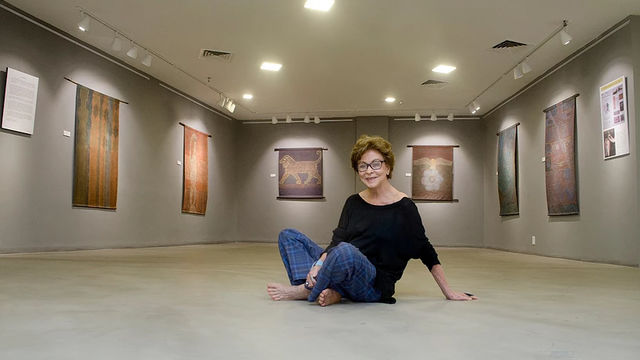
Yolanda Freyre
Iolanda Soares Freire Hinds, better known as Yolanda Freyre, was born in São Luís, Maranhão, in 1940. In 1967 she moved to Rio de Janeiro to start psychoanalysis; there she also began her artistic training. She attended the Escolinha de Artes do Brasil, where she studied art and education, woodcutting, and metal engraving. During this period her artistic production focused on social themes and representation of the Brazilian Northeast. Freyre's psychoanalytic sessions led her to produce india ink drawings inspired by a personal childhood imaginary. She came into contact with Ivan Serpa (1923–1973), who encouraged her to develop her work in drawing and painting; she then studied under him at the Centro de Pesquisa em Arte. She moved to Petrópolis, Rio de Janeiro, in the early 1970s, where she set up a studio. Her works from that time mainly portray the area around her home, such as Montanha do Quitandinha (Quitandinha Mountain, 1974), and the flowers in her garden. Freyre also created compositions that evoke a domestic environment, with elements traditionally associated with women, as in the painting Cabeça de galinha em toalha de crochê e hortênsia (Hen’s head on a crocheted tablecloth and hydrangea, 1974).
In the mid-1970s Freyre lost her brother, a victim of repression under the Brazilian military dictatorship. Driven by a sense of outrage, she began to approach this context of violence in her work. She staged marches and interventions, initially in public spaces, and later created performances in her home for select audiences. Throughout the 1970s the artist's work evolved in close connection with her interest in psychoanalysis, and her performances were marked by a ritual aspect. In Os passarinhos da figueira (The birds of the fig tree), presented at the Thirteenth Bienal de São Paulo (1975), the artist eats half a fig while the other half is eaten by a bird in a cage. In Mulher, o erótico na natureza (Woman, the erotic in nature, 1978), the artist records feminine forms in the landscape, creating relations between them and the notion of fertility. These performances were documented in book objects fashioned by Freyre, blending images with her own writings. Beginning in 1978 she took classes at the Escola de Artes Visuais do Parque Lage, where she studied under Lygia Pape (1927–2004). She began studies in social science at the Universidade Federal do Rio de Janeiro in 1980 but left the program and returned to Petrópolis, where she attended NEART (Núcleo Experimental de Arte). In the 1980s she produced paintings, with particular interest in color studies. Her work was exhibited in France in 1985, and she took classes at the Centre Saint-Charles, the art school of the Sorbonne. In the mid-1980s she made sculptures and installations that again drew on aspects of her childhood and the atmosphere of Maranhão. Subsequently she produced monochromatic paintings and concrete sculptures, reflecting her interest in materiality and geometry. Beginning in the late 1990s, the focus of her work returned to subjects connected with the domestic sphere, personal memories, nature, and motherhood.
—Amanda Arantes
Selected Exhibitions
1974 Pele de bicho ou Alma de flor, Centro de Pesquisa de Arte, Rio de Janeiro
1978 Mulher, o erótico na natureza, Museu de Arte Moderna do Rio de Janeiro
1985 Oils and Watercolors, Université des Sciences et Techniques du Languedoc, Montpellier, France
1991 Vermelhos, Museu Nacional de Belas Artes, Rio de Janeiro
1994 In Memoriam Per Vitae, The Pump House Gallery, London
Selected Bibliography
Arte do Maranhão 1940/1990. São Luís: Banco do Estado do Maranhão, 1994.
Catálogo Bienal de São Paulo, 13. São Paulo: Fundação Bienal, 1975.
Freyre, Yolanda. O Espelho do artista. Rio de Janeiro: Companhia de Freud, 2006.
Lopes, Fernanda. Área Experimental: Lugar, espaço e dimensão do experimental na arte brasileira dos anos 1970. São Paulo: Prestígio Editorial, 2013.
Moraes, Fabiana de, and Isabel Sanson Portella. Da escrita, delas, elas. Rio de Janeiro: Editora Circuito / Galeria do Lago / Museu da República, 2015.


